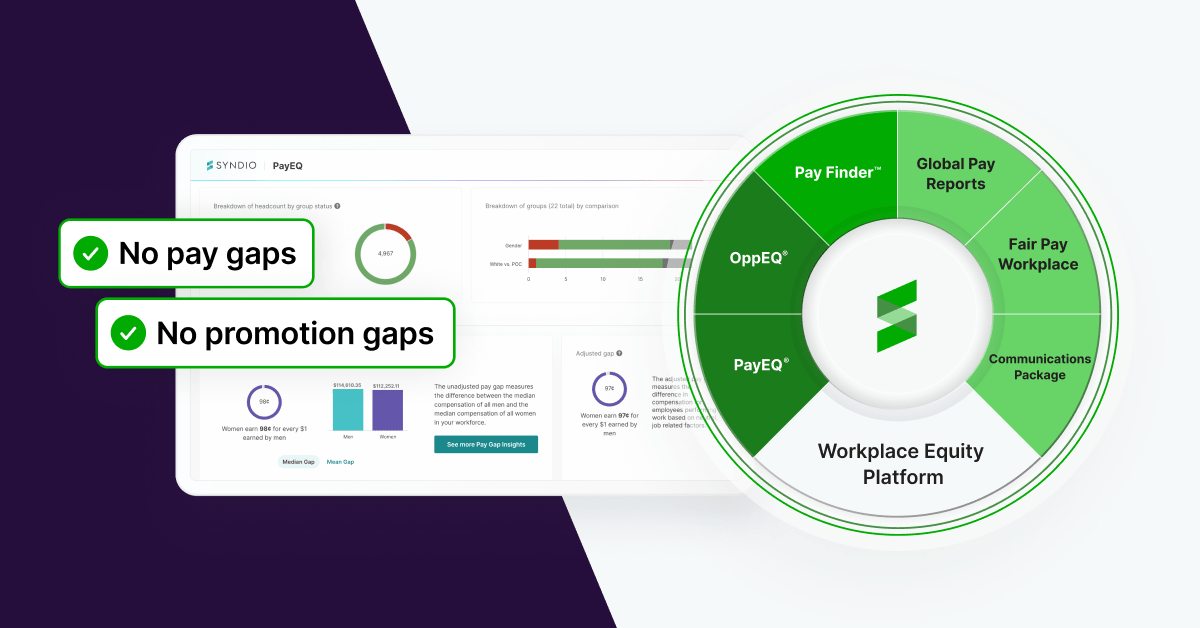Significant workforce changes with COVID followed by a national reflection on racial disparities have left many leaders considering steps to do more to support equality. True equity requires companies to embrace transparency and continuously commit to fair total compensation. For any organization interested in building an inclusive environment, fair pay is fundamental.
Definition of pay equity
Let’s start with the basics. What is pay equity?
Pay equity means paying people equally for doing the same, similar, or related work, regardless of protected category characteristics such as race, gender, or ethnicity. Any reasons for pay differences should be based on neutral, job-related factors like skills, effort, responsibility, and working conditions. In the U.S., pay equity is most commonly analyzed on the basis of gender and/or race or ethnicity, but it can be compared across any demographic including: age, sexual orientation, disability, caregiving status, and more.
→ Get the definition of pay equity and more in our Glossary of Workplace Equity Terms
How to embed fairness into Total Compensation programs
Our clients use a few simple steps to make a big impact on their Total Compensation programs.
1. Prepare senior leadership and commit to action.
Before embarking on an effort to analyze and fix pay disparities due to gender, race and ethnicity, align and prepare senior leadership. It’s important they know that virtually every company in America will have pockets of disparity. Race and gender wage gaps exist wherever there is discretion and, on balance, across large populations, this favors men.
Because surprise is often a cardinal sin, set expectations accordingly and level-set on the definition of pay equity. Perhaps most importantly, ensure alignment that whatever is found will be addressed. The only thing worse than not examining whether there is a problem is finding an issue and doing nothing about it.
Don’t oversell fear. The fact that nearly all companies — even the best and most progressive— will have gaps to fix should bring some degree of comfort, not fear. Finding and fixing them might be uncomfortable but it remains a better (and less costly over the long run) alternative to ignoring them. Not examining under the hood does not mean the rust isn’t there.
2. Conduct a pay equity analysis.
There are several ways to do conduct a pay equity analysis. Some do it internally by hand; some use external counsel and a labor economist; some use specialized pay equity software.
Do not be intimidated by the math. Critical to a valid pay equity analysis is proper grouping. This means grouping those who perform substantially similar work when viewing their jobs as a composite of skill, effort, and responsibility. The same data grouped differently can yield different results, so do not “divide and hide” — grouping employees too narrowly and viewing everyone as a unique snowflake, each with very different work. The recent Oracle gender pay class certification ruling explains why Courts disfavor this sort of disaggregation. The goal is not to find groupings that appear to show the company in most favorable light, but to find those issues that need to be fixed.
Analyze all elements of compensation: base pay, bonus, and stock. Some companies analyze only base pay, which is a mistake. There are no “bonus and stock” exceptions to federal and state pay equity laws. Plus, discretionary comp elements like bonuses and stock awards are often where disparities are buried. Discretion is where bias can lurk, so investigate those areas and fix them.
The good news is that there are certain principles to help govern how to conduct a pay equity analysis the right way. A group of progressive corporate, academic and former government officials agreed upon them here.
3. Communicate results and schedule regular reviews.
Once you’ve completed the analysis, communicate the results back to senior leadership. Ideally, and if done correctly, you’ve not only identified what areas need remediation (ie, some payment), you’ve identified any underlying policy, practice or behavior that need attention. Remediating alone often leads to disparities reappearing because the underlying causes of the issues go unattended. Remediating fixes the symptoms, not the problems.
For example, the single most significant factor in any pay analysis is starting pay. That is, the way in which most companies set starting pay — upon new hire or promotion — embeds and perpetuates unlawful pay disparities. There are several things a company can do to ensure this isn’t happening, but that’s another topic entirely.
To be effective, analyze compensation regularly. Changes in the workforce — turnover, off-cycle bonuses or stock awards, promotions — will affect results. The companies that are best at pay equity get into a rhythm of analyzing during the merit cycle, so they are reviewing and adjusting proposed but not-yet-final pay, and check and adjust throughout the year.



